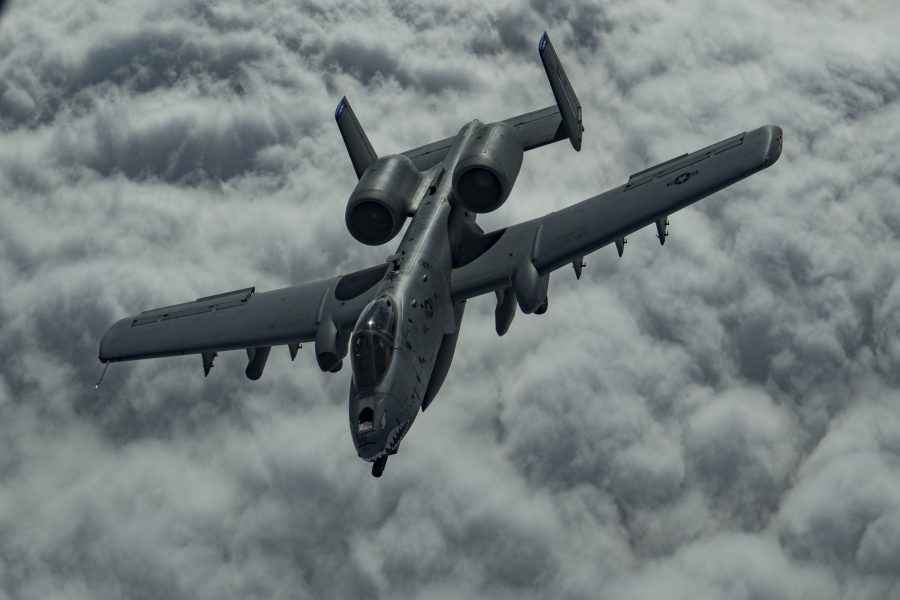The A-10 “Warthog” is a specialized CAS aircraft tasked with interdiction, Forward Air Controller-Airborne (FAC-A), CSAR, and Strike Control & Reconnaissance. It combines a heavy, diverse weapons load with low-level maneuverability, a large combat radius, and long loiter time.
The A-10 is capable of carrying up to 16,000 lb of ordnance in addition to its 30 mm cannon which can destroy heavy armor while the pilot is protected by a titanium-armored cockpit.
 The prototype YA-10A first flew on May 10, 1972, winning USAF’s A-X competition for a new attack aircraft. The A-10A development aircraft first flew on Feb. 15, 1975, and A-10As were delivered between October 1975 and March 1984. USAF declared A-10A IOC in October 1977.
The prototype YA-10A first flew on May 10, 1972, winning USAF’s A-X competition for a new attack aircraft. The A-10A development aircraft first flew on Feb. 15, 1975, and A-10As were delivered between October 1975 and March 1984. USAF declared A-10A IOC in October 1977.
The fleet was modernized under the Precision Engagement Program, resulting in the A-10C which first flew at Eglin in 2005. The A-10C adds color cockpit MFDs, a Helmet Mounted Cueing System (HMCS), Handson Throttle and Stick, digital stores management, improved fire-control, GPS-guided weapons, Litening/Sniper pods, advanced data links, and integrated sensors.
The A-10C debuted in combat during Iraqi Freedom in 2007. With NVGs and targeting pods, the A-10C can operate under ceilings as low as 1,000 ft including at night. The Operational Flight Program (OFP) continuously updates the A-10’s systems and software, and following current OFP Suite 11 the program will shift to more frequent rolling software upgrades.
USAF did not request FY24 modernization funding, though FY23 supported replacing primary cockpit instruments with a high-resolution digital glass display, adding directional audio threat cueing, modernizing ARC-210 UHF/VHF comms, adding Ethernet, integrating Small Diameter Bomb I, and transition to Onboard Oxygen Generation Systems (OBOGS). Re-winging is key to the aircraft’s longevity and extends airframe life to at least 10,000 hours.
A total of 173 aircraft received new wingsets prior to modifications recommencing in 2022, and all remaining aircraft will be re-winged through FY26. Congress lifted its ban on A-10 divestitures in FY23, allowing the service to cut the Indiana ANG’s 21 aircraft. The ANG announced Idaho’s 124th Fighter Wing will follow suit in early 2027, and USAF plans to continue retirements in FY24.
ACC plans to eliminate 42 A-10s from Davis-Monthan and Moody, eventually reducing the fleet to 218 upgraded aircraft which will fly through 2030 or beyond. USAF surged A-10 deployments to CENTCOM following Hamas terrorist attacks on Israel in October 2023, with units from Davis-Monthan augmenting aircraft deployed from Moody through the end of the year.
Contractors: Fairchild Republic (Lockheed Martin); Boeing (re-wing).
First Flight: Jan. 20, 2005 (A-10C).
Delivered: 2006-2012 (A-10C).
IOC: September 2007 (A-10C).
Production: 713
Inventory: 281
Operator: ACC, AFMC, PACAF, ANG, AFRC.
Aircraft Location: Barksdale AFB, La.; Boise Air Terminal, Idaho; DavisMonthan AFB, Ariz.; Eglin AFB, Fla.; Fort Wayne Arpt., Ind.; Martin State Arpt., Md.; Moody AFB, Ga.; Nellis AFB, Nev.; Osan AB, South Korea; Selfridge ANGB, Mich.; Whiteman AFB, Mo.
Active Variant: •A-10C. Upgraded version of the A-10A ground attack aircraft.
Dimensions: Span 57.5 ft, length 53.3 ft, height 14.7 ft.
Weight: Max T-O 51,000 lb.
Power Plant: Two GE Aviation TF34-GE-100 turbofans, each 9,065 lb thrust.
Performance: Speed 518 mph, range 800 miles (further with air refueling).
Ceiling: 45,000 ft.
Armament: One internally mounted 30 mm, seven-barrel GAU-8/A cannon (1,174 rd of high-explosive incendiary (HEI) or HEI/armor-piercing incendiary); four AIM-9 Sidewinders, AGM-65 Mavericks, laser-guided rockets, most free-fall or guided air-to-surface weapons in USAF inventory, and ECM pods.
Accommodations: Pilot on ACES II zero/zero ejection seat.
